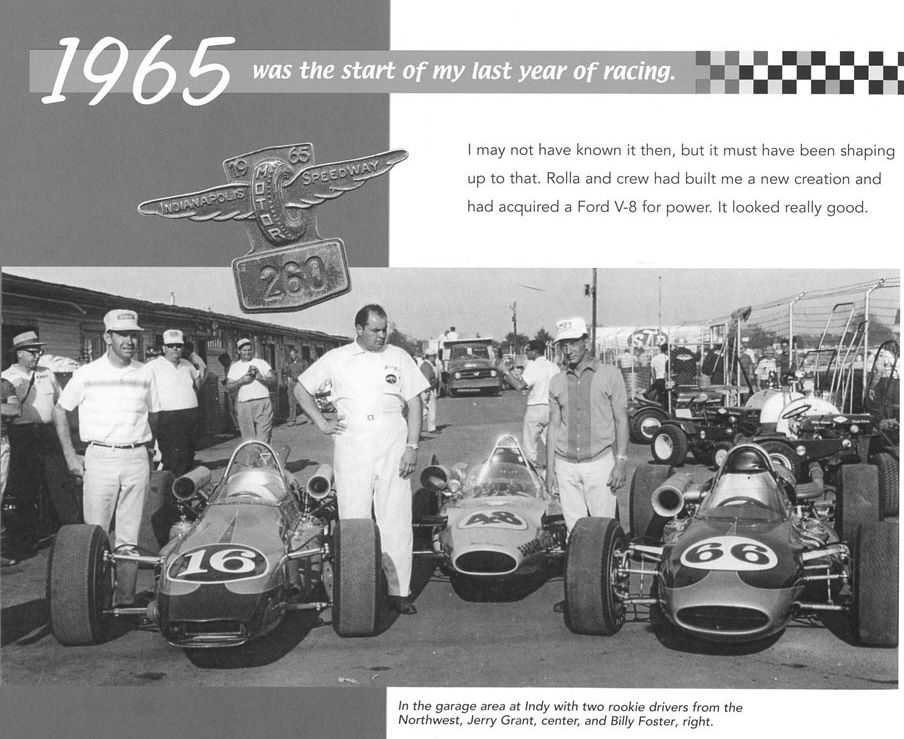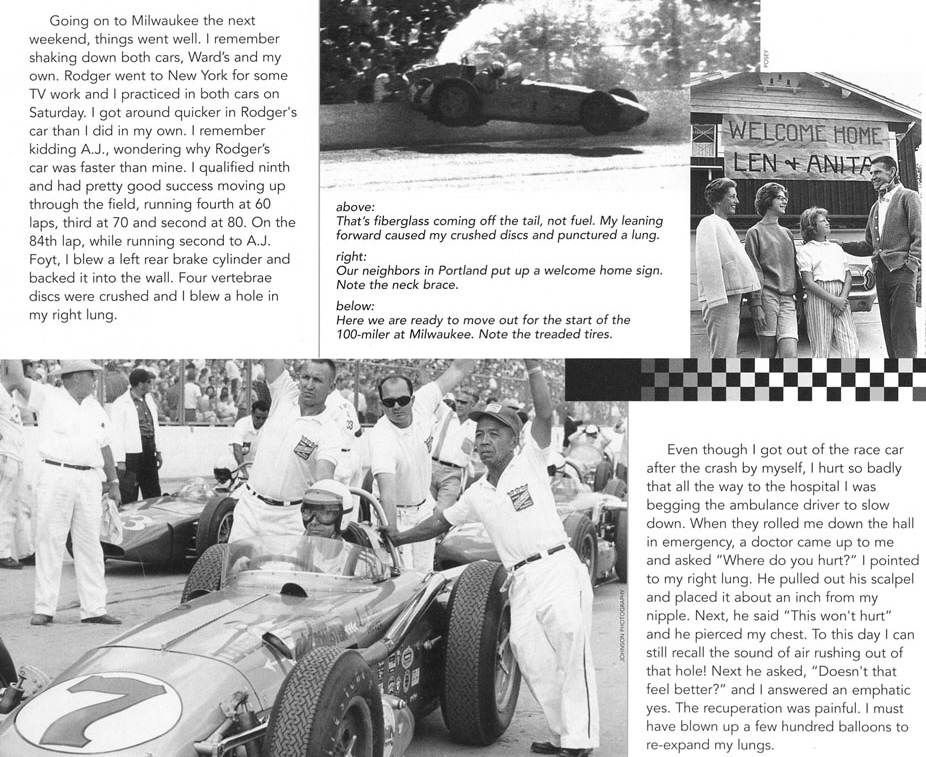My Road to Indy, a narrative by Len Sutton
Submitted by Admin on

Book Review by Richard Parks, Photographic Consultant Roger Rohrdanz


My Road to Indy; a narrative by Len Sutton is a 10 by 9 inch hard cover book telling the story of Len Sutton, a prominent car racer from the Pacific Northwest. The book has an appealing coffee table look to it, but comes without a dust jacket. There were two thousand copies made, so it is in a limited run, but there are still books left from the second printing. The quality of the book and the paper used is excellent. There are 94 pages with adequate text to tell the story and 173 first class photos throughout the book. Of the photos, 5 are in color and 168 are in black and white or sepia toned. The reason for the preponderance of black and white photos is due to the fact that Sutton’s racing career began in the 1940’s, continuing through the 1960’s. Color photos wouldn’t have enhanced the style any more than the black and white photos and the overall quality is very high. There are twenty additional charts, maps and other interesting drawings that help to tell Sutton’s story. The forward is by Donald Davidson, well known Indianapolis Motor Speedway Historian. A short dedication is followed by a clear and concise table of contents and five chapters, averaging about 18 pages each. The book ends with an acknowledgment, credits, two pages of statistics and a very thorough index. The book itself shows a great deal of care in the crafting and quality of the overall look and having an index makes it easy to review back and check the material. The listed price is $39 (includes shipping/handling) and is published by the author, with the printing done by Walsworth Publishing Company, Marceline, Missouri. The cover and book design was done by Christy Sutton, the author’s daughter and the ISBN number is 0-9725421-0-8. The book is available through www.lensutton.com.
Len Sutton has recently passed away and we have lost another one of those legendary men and women who raced during the golden age of open wheel racing. Some of those great car racers of that era were Rodger Ward, Parnelli Jones, Billy Vukovich, Dick Rathmann, Troy Ruttman, Eddie Sachs, Lloyd Ruby and Tony Bettenhausen. The layout of the book makes it easy to read and the tables and charts help the reader to see the progression in Sutton’s life. Chapter One begins with his youth and a little known incident where as a two-year-old he fell into a well and was buried in dirt for two hours. Len was always energetic and held a paper route and trapped muskrats for their pelts during the Great Depression. He enlisted in the Navy during World War II and flew in B-26’s. Sutton was discharged in 1945 and returned to his hometown of Portland, Oregon, where he soon took to driving track roadsters. His big break came when he met Rolla Vollstedt and George “Pop” Koch. The team became very successful with Sutton driving, Vollstedt as the car owner and Koch as the chief mechanic and car builder. Sutton raced successfully in the Pacific Northwest then went south to California and racetracks like Carrell Speedway and Huntington Beach. It wasn’t long before he took up midget racing with a powerful Offy engine. Sutton won the Pacific Northwest track roadster championship from 1951-53 in Vollstedt’s car. In 1954, he replaced Jack McGrath in Ranald Ferguson’s ’53 Lincoln and drove the Panamericana Mexican Road race. He crashed the car trying to avoid some cattle that had wandered onto the road and ended up in a body cast for four months.
Len moved up to Sprint cars and had a string of successes to his credit, which enabled him to qualify for the Big Race, the Indy 500. He had dominated the Pacific Northwest in track roadsters, midgets and sprint cars throughout the first half of the 1950’s, and now he turned his attention to competing against the best racers in the country. Sutton did quite well and finished in the top 20 or better in each year from 1957 through the end of his racing career. He passed his rookie test at the Indy 500 in 1956, but a serious crash put him out of the race. Sutton was now married and he and his wife Anita had two daughters, Christy and Hollie. He didn’t race at the 500 in 1957, but in 1958 he started 27 and an accident on the first lap put his car out of the race. He finished 32, but he had made the race. In 1959, Sutton had slightly better luck, lasting 34 laps and then hitting the wall, giving him another 32nd finish, but he had moved up to the 22nd starting position. From then on Len would start no worse than 12th and would have a 4th, 5th and two 8th positions, putting him in a good spot to win it all. Luck plays a large role in who will win at Indy and who won’t. In 1960 he started 5th but engine trouble on the 47th lap put him out of the race and he finished 30th overall. In 1961 he was 8th starting the race and transmission failure on the 110th lap ended his day, though he improved to a 19th place showing. In 1962 his teammate was Rodger Ward, one of the greatest drivers America has ever produced. Sutton started 4th overall; his best showing ever at Indy and this time his car didn’t fail him. He came in second that year to Ward, only 11 seconds behind. Len failed to make the field at the 1963 Indy 500 and though he placed 15th in 1964, and 12th in 1965, his chance for victory at the 500 had passed him by.
At a race in Milwaukee after his close loss to Ward in 1962, Sutton crashed and crushed the discs in his back and punctured a lung. He recovered to finish out the season. Rolla Vollstedt had developed a rear-engined car, sleek and aerodynamic. It had taken all of 1963 and ’64 to perfect but the speeds had impressed others and A.J. Watson had made two cars after watching Rolla’s car perform. Sutton’s car performed well and he was in a good position, but Dave MacDonald’s car collided with Eddie Sachs creating a terrible crash and tremendous fireball. Len managed to drive around it but the race was stopped. The race was restarted an hour and a half later but a parts failure ended Sutton’s second best chance at winning the 500, and giving the rear-engined car that glory of victory. Len was also racing stock cars and placed tenth in 1964. Vollstedt designed a new car for Sutton in the 1965 race, and it gave the team nothing but trouble. An oil leak proved hard to stop, then during a pit stop the spark plugs were replaced and finally the fuel injector nozzles were tweaked. That slowed the car enough to put it out of serious contention, but Sutton still managed to bring the car into a 12th place finish. Len raced at Milwaukee, where he crashed twice and this time did not qualify. Langhorne was his next race and he had a muscle cramp that almost put him out of the race. Mel Kenyon was seriously burned in an accident and Sutton began to think that it was time to retire and think of his family. Len Sutton was a remarkable racer and his story is a compelling one for motor racing enthusiasts. He has left behind a book that will entertain and enlighten the most avid fan of racing.
From The Book

A page from the book. Pictured (l-r) Len Sutton, Jerry Grant, and Billy Foster

A page from the book showing Len’s 1962 crash
